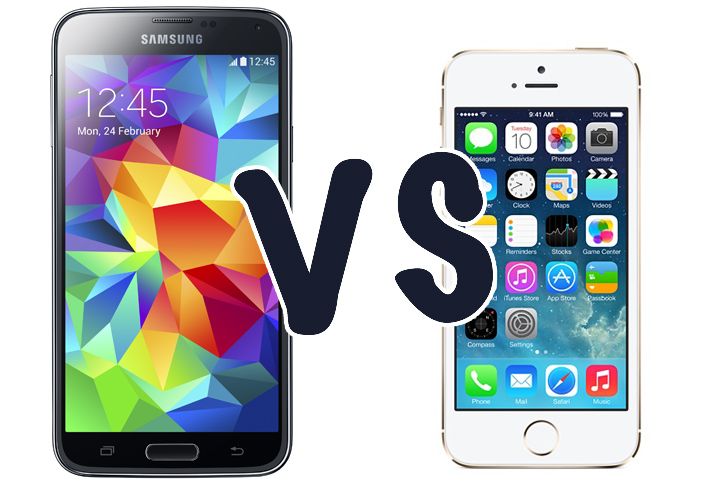Samsung has released its Galaxy S5 smartphone, possibly to capitalise on the brief gap in availability between it and bitter rival Apple's own flagship phone, the iPhone 5S.
There's definitely an advantage to hindsight though, with the Galaxy S5 feature set benefitting from the extra time in development. But how much so? And does the iPhone trounce its Android chum in other ways? There's only one way to find out...
READ: Samsung Galaxy S5 review
Screen
The Samsung Galaxy S5 has a 5.1-inch Super AMOLED 1920 x 1080 screen. The iPhone 5S cedes a lot of ground in real estate, therefore, able to boast only a 4-inch screen with an 1136 x 640 pixel resolution. It is a Retina display though and is quite extraordinary in its brightness and sharpness.
Build
As with many other phones in the Samsung stable, the Galaxy S5 is a plastic device essentially, with the same material used for the rear casing as in previous years. The iPhone 5S is a solid device with an aluminium back and sides that feels classy in comparison.
It is also super light in weight. Both are, to be fair, but the smaller dimensions mean the iPhone is considerably more so. It weighs 112g in comparison to the S5's 145g.
The Samsung Galaxy S5 is massive when the phones are set side by side. It measures 142 x 72.5 x 8.1mm, while the iPhone 5S is 123.8 x 58.6 x 7.6mm. That last measurement means the iPhone is thinner.
The big positive for the SGS5 is that it is completely dustproof and resistant in liquid down to a metre in depth (grade IP67). That means it is far better suited to harsh environments than Apple's phone.
Sensors
The Galaxy S5 is the first of Samsung's handsets to feature a fingerprint sensor for security. This was something brought to market last august by Apple, so there's an element of catch-up being played in this sense.
The Samsung version requires you to swipe across the home button on the front and Apple's a finger press. Other than that they perform the same function.
Samsung does have one trick up its sleeve: as well as a fingerprint sensor on the front, there's a heart rate monitor on the rear. Hold your finger to it and it will be able to read your heart rate for use in fitness applications.
Processor
It's hard to judge which will be the faster phone until we have them side by side in the Pocket-lint test labs. The main problem is that they use dramatically different architecture and Apple doesn't really expose its frequency speeds or such like.
The Samsung Galaxy S5 runs on a 2.5GHz quad-core Qualcomm Snapdragon 801 processor that is considerably quicker in certain processes to its predecessor (Snapdragon 800). It also has 2GB of RAM.
The Apple device uses the company's A7 chip with a 64-bit architecture. The latter should technically be faster, but often things aren't that simple.
Camera
Samsung has a massive advantage in camera terms over its rival. The Galaxy S5 sports a 16-megapixel rear camera with 4K (UHD) video recording capability. The iPhone 5S has an 8-megapixel camera, so there's not really any comparison in terms of sensor size.
Again, we'd have to compare them out in the field when the SGS5 is available for a proper test, but the 4K video recording is a vast improvement on the iPhone's 1080p maximum limit. Both recording at their fullest in 30 frames per second.
The front cameras are as diverse too. The S5 has a 2.1-megapixel sensor capable of recording in 1080p while the iPhone has a 1.2-megapixel snapper capable of 720p for FaceTime primarily.
Conclusion
To be honest, the iPhone 5S and Samsung Galaxy S5 are chalk and cheese. Certainly, the latter seems to be the more powerful of the two devices in feature set and numerous technological advances, but it perhaps is so in detriment to style. The iPhone 5S is a sexy fashion symbol, the new Samsung phone seems more geared to functionality.
That is what will split opinions for many, while the old battle between iOS 7 and Android will sort out the rest. One thing is for sure, both phones are worthy flag wavers for their respective brands.

